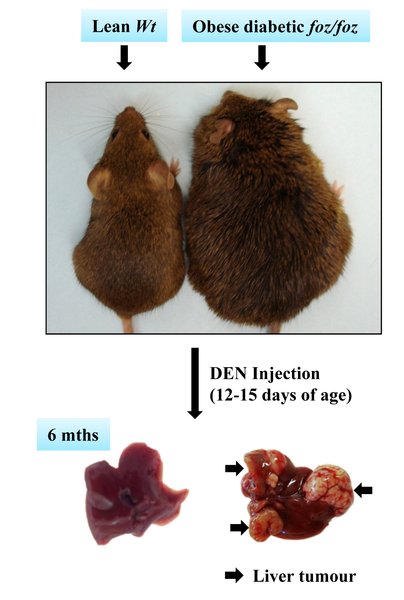-
Home
-
About JCTR
-
Gold Open Access
-
Issues
-
Editorial board
-
Author guidelines
-
Publication fees
-
Online first
-
Special issues
-
News
-
Publication ethics
-
Partners
-
Submit your manuscript
-
Submit your review report
-
Editorial Office
-

This work is licensed under a Creative Commons Attribution-NonCommercial 4.0 International License. ISSN print: 2382-6533 ISSN online: 2424-810X
Volume 2 Issue 1
Obesity and diabetes accelerate hepatocarcinogenesis via hepatocyte proliferation independent of NF-kB or Akt/mTORC1
Evi Arfianti, Claire Z Larter, Seungsoo Lee, Vanessa Barn, Geoffrey Haigh, Matthew M Yeh, George Ioannou, Narci C Teoh, Geoffrey C Farrell
Arfianti et al., J Clin Transl Res, 2016; 2(1): 26-37
Published online: 19 January, 2016
Abstract
Background: There are strong links between obesity, diabetes and hepatocellular carcinoma (HCC), but molecular mechanisms remain unclear.
Aims: We tested the proposed involvement of NF-kB, IL-6/STAT3 and Akt/mTORC1 before onset (at 3 months) and at onset (6 months) of accelerated hepatocarcinogenesis in DEN-injected obese and diabetic foz/foz compared to lean wildtype (Wt) mice, and also studied the hepatocyte proliferative response to DNA damage between the obese and lean lines.
Methods: Male foz/foz and Wt littermates fed normal chow were DEN-injected (10 mg/kg i.p.) at age 12-15 days. To test the effect of mTOR inhibitor on growth of dysplastic hepatocytes, a separate cohort of DEN-injected foz/foz mice was administered rapamycin (4 mg/kg body weight/day).
Results: foz/foz mice developed obesity, hyperinsulinemia, diabetes, adipokine dysregulation and fatty liver, without increased serum or liver TNF-α or serum IL-6. All DEN-injected foz/foz mice developed HCC by 6 mths vs. 0/10 lean Wt. At 3 mths, there were more dysplastic hepatocytes in DEN-injected foz/foz than Wt, with increased liver injury (serum ALT), hepatocyte apoptosis (M30-positive cells) and proliferation (cyclin D1, cyclin E, PCNA), but neither NF-kB nor STAT3 activation. foz/foz livers exhibited upregulation of DNA damage sensors ATM and ATR, with inadequate cell cycle checkpoint controls (CHK1, CHK2, p53, p21). Akt and mTORC1 were highly activated in livers from foz/foz vs. Wt mice. Despite such activation, rapamycin failed to reduce growth of dysplastic hepatocytes.
Conclusions: Accelerated DEN-induced HCC in obese/diabetic mice is linked to enhanced growth of dysplastic hepatocytes that cannot be attributed to NF-kB or IL-6/STAT3 activation, nor to sustained mTORC1 activation. The critical mechanism for obesity-enhanced hepatocarcinogenesis lies in the disconnection between hepatocellular injury with DNA damage, and an unrestrained proliferative response.
Relevance for patients: This study supports the epidemiological data linking obesity, diabetes and fatty liver disease with increased risk for developing HCC. The findings also suggest that mTORC1 inhibition may not be beneficial in the prevention of obesity-related hepatocarcinogenesis.

DOI: http://dx.doi.org/10.18053/jctres.02.201601.001
Author affiliation
Australian National University Medical School, Canberra, Act Australia
*Corresponding author:
Geoffrey C. Farrell
Liver Research Group, Australian National University Medical School, Level 5, Building 10, the Canberra Hospital, Yamba Drive, Garran, ACT 2605, Australia
Email: geoff.farrell@anu.edu.au
Handling editor:
Michal Heger
Department of Experimental Surgery, Academic Medical Center, University of Amsterdam, Amsterdam, The Netherlands

